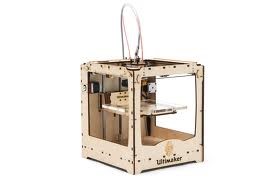The Ultimaker 3D printer is a DIY kit for people who want a good, fast, and efficient machine for a relatively low price – and don’t mind having to put all the parts together themselves. Developed by three Dutch Makerbot fans, the Ultimaker 3D printer surpasses its predecessor in almost every way, and is now the most advanced of the RepRap progeny. Ultimaker is like the Makerbot Replicator 2 on steroids; its build volume is roughly 592 cubic inches versus Replicator 2’s 410 cubic inches. It prints much faster, too, at astonishing 5.9 inches per second, making it a very good 3D printer.
How Does the Ultimaker 3D printer work?
The Ultimaker utilizes Fused Filament Fabrication technology – another name for TPE, or thermoplastic extrusion. However, its design is vastly superior to other 3D printers utilizing the same technology in the same price range. As already said, it is able to print at incredible speeds, achieved by using stepper motors mounted on a printer frame and a printing head that moves along two axes. In fact, when the Ultimaker is assembled properly, well-tuned and lubricated, it may go from 0 inches/second to 15.7 inches/second in a blink of an eye (here’s the video of its amazing speed). However, it’s currently unable to consistently print at 15.7 inches per second – the software actually cannot process the movement pattern of the printing head fast enough. The good news is that the Ultimaker community is working on a software upgrade that will allow this bottleneck to be surpassed. The bad news is that no one really knows when the upgrade will come out.
| Ultimaker 3D Printer Specifications and Information | |
|---|---|
| Technology | FFF (Fused Filament Fabrication) aka TPE (Thermoplastic Extrusion) |
| Frame Size (Width x Depth x Height) | ~ 14" x 14" x 15.3"/ ~ 34 x 35.5 x 39 cm |
| Weight | ~ 20lbs / ~ 9 kg |
| Build materials |
|
| Materials used | Chrome plated hardened steel precision rods, brass bushings and linear ball bearings |
| Speed | Max. head travel speed ~ 15.7"/s / 400mm/s. |
| Accuracy | 0.05 mm |
| Build volume (X,Y,Z) | 8.27" x 8.27" x 8.67"/ ~ 210 x 210 x 220 mm |
| Price | €1,194.00 at the Ultimaker shop |
| Price of material | €31.50 per 0.75kg at the Ultimaker shop |
| Manufacturer’s website and contacts | http://www.ultimaker.com/ |
| Guides and books | Ultimaker wiki; models can be downloaded at Thingiverse |
Pros:
As you can see from the specs, the Ultimaker is a very, very powerful 3D printer. It’s accurate for the technology used, fast compared to similar machines, can print large parts, has a large selection of materials, is robust and is also very convenient – that is, once you set it up properly. It has a solid range of good printing materials, allowing you to print for a wide array of applications. Plus it’s currently nowhere near its potential – and there’s an ongoing community effort to remedy that.
Cons:
It’s not as precise as the MakerBot Replicator 2. It also comes as a DIY kit, meaning you WILL have to spend some time putting it together, and it will take some effort getting it to work properly. That said, if you have experience with mechanics, you shouldn’t have much problem with that, as the Ultimaker wiki provides a good guide on making the 3D printer work. It’s also more expensive than many other 3D printers, but then again, it can do much more, too. Finally, the parts produced may be a bit weaker than molded plastic – but that depends on the specs of the part itself, and the flaw can be circumvented.
The Bottom Line:
The Ultimaker 3D printer is one of the best choices for any serious hobbyist. Its pros far outweigh its cons. However, if you just want to try out 3D printing, a cheaper, simpler model might be a better solution.

